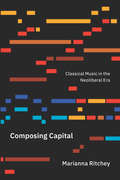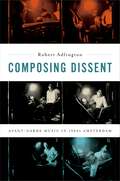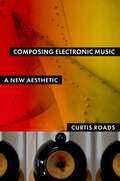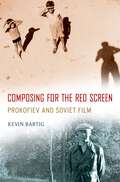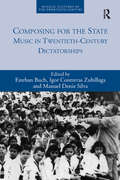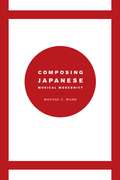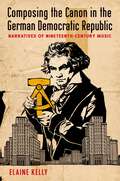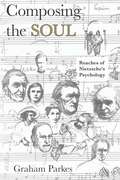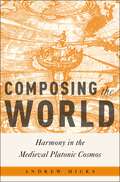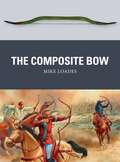- Table View
- List View
Composing Capital: Classical Music in the Neoliberal Era
by Marianna RitcheyThe familiar old world of classical music, with its wealthy donors and ornate concert halls, is changing. The patronage of a wealthy few is being replaced by that of corporations, leading to new unions of classical music and contemporary capitalism. In Composing Capital, Marianna Ritchey lays bare the appropriation of classical music by the current neoliberal regime, arguing that artists, critics, and institutions have aligned themselves—and, by extension, classical music itself—with free-market ideology. More specifically, she demonstrates how classical music has lent its cachet to marketing schemes, tech firm-sponsored performances, and global corporate partnerships. As Ritchey shows, the neoliberalization of classical music has put music at the service of contemporary capitalism, blurring the line between creativity and entrepreneurship, and challenging us to imagine how a noncommodified musical practice might be possible in today’s world.
Composing Capital: Classical Music in the Neoliberal Era
by Marianna RitcheyThe familiar old world of classical music, with its wealthy donors and ornate concert halls, is changing. The patronage of a wealthy few is being replaced by that of corporations, leading to new unions of classical music and contemporary capitalism. In Composing Capital, Marianna Ritchey lays bare the appropriation of classical music by the current neoliberal regime, arguing that artists, critics, and institutions have aligned themselves—and, by extension, classical music itself—with free-market ideology. More specifically, she demonstrates how classical music has lent its cachet to marketing schemes, tech firm-sponsored performances, and global corporate partnerships. As Ritchey shows, the neoliberalization of classical music has put music at the service of contemporary capitalism, blurring the line between creativity and entrepreneurship, and challenging us to imagine how a noncommodified musical practice might be possible in today’s world.
Composing Capital: Classical Music in the Neoliberal Era
by Marianna RitcheyThe familiar old world of classical music, with its wealthy donors and ornate concert halls, is changing. The patronage of a wealthy few is being replaced by that of corporations, leading to new unions of classical music and contemporary capitalism. In Composing Capital, Marianna Ritchey lays bare the appropriation of classical music by the current neoliberal regime, arguing that artists, critics, and institutions have aligned themselves—and, by extension, classical music itself—with free-market ideology. More specifically, she demonstrates how classical music has lent its cachet to marketing schemes, tech firm-sponsored performances, and global corporate partnerships. As Ritchey shows, the neoliberalization of classical music has put music at the service of contemporary capitalism, blurring the line between creativity and entrepreneurship, and challenging us to imagine how a noncommodified musical practice might be possible in today’s world.
Composing Dissent: Avant-garde Music in 1960s Amsterdam
by Robert AdlingtonThe 1960s saw the emergence in the Netherlands of a generation of avant-garde musicians (including figures such as Louis Andriessen, Willem Breuker, Reinbert de Leeuw and Misha Mengelberg) who were to gain international standing and influence as composers, performers and teachers, and who had a defining impact upon Dutch musical life. Fundamental to their activities in the sixties was a pronounced commitment to social and political engagement. The lively culture of activism and dissent on the streets of Amsterdam prompted an array of vigorous responses from these musicians, including collaborations with countercultural and protest groups, campaigns and direct action against established musical institutions, new grassroots performing associations, political concerts, polemicising within musical works, and the advocacy of new, more 'democratic' relationships with both performers and audiences. These activities laid the basis for the unique new music scene that emerged in the Netherlands in the 1970s and which has been influential upon performers and composers worldwide. This book is the first sustained scholarly examination of this subject. It presents the Dutch experience as an exemplary case study in the complex and conflictual encounter of the musical avant-garde with the decade's currents of social change. The narrative is structured around a number of the decade's defining topoi: modernisation and 'the new'; anarchy; participation; politics; self-management; and popular music. Dutch avant-garde musicians engaged actively with each of these themes, but in so doing they found themselves faced with distinct and sometimes intractable challenges, caused by the chafing of their political and aesthetic commitments. In charting a broad chronological progress from the commencement of work on Peter Schat's Labyrint in 1961 to the premiere of Louis Andriessen's Volkslied in 1971, this book traces the successive attempts of Dutch avant-garde musicians to reconcile the era's evolving social agendas with their own adventurous musical practice.
Composing Egypt: Reading, Writing, and the Emergence of a Modern Nation, 1870-1930
by Hoda A. YousefIn this innovative history of reading and writing, Hoda Yousef explores how the idea of literacy and its practices fundamentally altered the social fabric of Egypt at the turn of the twentieth century. She traces how nationalists, Islamic modernists, bureaucrats, journalists, and early feminists sought to reform reading habits, writing styles, and the Arabic language itself in their hopes that the right kind of literacy practices would create the right kind of Egyptians. The impact of new reading and writing practices went well beyond the elites and the newly literate of Egyptian society, and this book reveals the increasingly ubiquitous reading and writing practices of literate, illiterate, and semi-literate Egyptians alike. Students who wrote petitions, women who frequented scribes, and communities who gathered to hear a newspaper read aloud all used various literacies to participate in social exchanges and civic negotiations regarding the most important issues of their day. Composing Egypt illustrates how reading and writing practices became not only an object of social reform, but also a central medium for public exchange. Wide segments of society could engage with new ideas about nationalism, education, gender, and, ultimately, what it meant to be part of "modern Egypt."
Composing Electronic Music: A New Aesthetic
by Curtis RoadsElectronic music evokes new sensations, feelings, and thoughts in both composers and listeners. Opening the door to an unlimited universe of sound, it engages spatialization as an integral aspect of composition and focuses on sound transformation as a core structural strategy. In this new domain, pitch occurs as a flowing and ephemeral substance that can be bent, modulated, or dissolved into noise. Similarly, time occurs not merely as a fixed duration subdivided by ratios, but as a plastic medium that can be generated, modulated, reversed, warped, scrambled, and granulated. Envelope and waveform undulations on all time scales interweave to generate form. The power of algorithmic methods amplify the capabilities of music technology. Taken together, these constitute game-changing possibilities. This convergence of technical and aesthetic trends prompts the need for a new text focused on the opportunities of a sound oriented, multiscale approach to composition of electronic music. Sound oriented means a practice that takes place in the presence of sound. Multiscale means an approach that takes into account the perceptual and physical reality of multiple, interacting time scales-each of which can be composed. After more than a century of research and development, now is an appropriate moment to step back and reevaluate all that has changed under the ground of artistic practice. Composing Electronic Music outlines a new theory of composition based on the toolkit of electronic music techniques. The theory consists of a framework of concepts and a vocabulary of terms describing musical materials, their transformation, and their organization. Central to this discourse is the notion of narrative structure in composition-how sounds are born, interact, transform, and die. It presents a guidebook: a tour of facts, history, commentary, opinions, and pointers to interesting ideas and new possibilities to consider and explore.
Composing Electronic Music: A New Aesthetic
by Curtis RoadsElectronic music evokes new sensations, feelings, and thoughts in both composers and listeners. Opening the door to an unlimited universe of sound, it engages spatialization as an integral aspect of composition and focuses on sound transformation as a core structural strategy. In this new domain, pitch occurs as a flowing and ephemeral substance that can be bent, modulated, or dissolved into noise. Similarly, time occurs not merely as a fixed duration subdivided by ratios, but as a plastic medium that can be generated, modulated, reversed, warped, scrambled, and granulated. Envelope and waveform undulations on all time scales interweave to generate form. The power of algorithmic methods amplify the capabilities of music technology. Taken together, these constitute game-changing possibilities. This convergence of technical and aesthetic trends prompts the need for a new text focused on the opportunities of a sound oriented, multiscale approach to composition of electronic music. Sound oriented means a practice that takes place in the presence of sound. Multiscale means an approach that takes into account the perceptual and physical reality of multiple, interacting time scales-each of which can be composed. After more than a century of research and development, now is an appropriate moment to step back and reevaluate all that has changed under the ground of artistic practice. Composing Electronic Music outlines a new theory of composition based on the toolkit of electronic music techniques. The theory consists of a framework of concepts and a vocabulary of terms describing musical materials, their transformation, and their organization. Central to this discourse is the notion of narrative structure in composition-how sounds are born, interact, transform, and die. It presents a guidebook: a tour of facts, history, commentary, opinions, and pointers to interesting ideas and new possibilities to consider and explore.
Composing for the Red Screen: Prokofiev and Soviet Film (Oxford Music / Media)
by Kevin BartigSound film captivated Sergey Prokofiev during the final two decades of his life: he considered composing for nearly two dozen pictures, eventually undertaking eight of them, all Soviet productions. Hollywood luminaries such as Gloria Swanson tempted him with commissions, and arguably more people heard his film music than his efforts in all other genres combined. Films for which Prokofiev composed, in particular those of Sergey Eisenstein, are now classics of world cinema. Drawing on newly available sources, Composing for the Red Screen examines - for the first time - the full extent of this prodigious cinematic career. Author Kevin Bartig examines how Prokofiev's film music derived from a self-imposed challenge: to compose "serious" music for a broad audience. The picture that emerges is of a composer seeking an individual film-music voice, shunning Hollywood models and objecting to his Soviet colleagues' ideologically expedient film songs. Looking at Prokofiev's film music as a whole - with well-known blockbusters like Alexander Nevsky considered alongside more obscure or aborted projects - reveals that there were multiple solutions to the challenge, each with varying degrees of success. Prokofiev carefully balanced his own populist agenda, the perceived aesthetic demands of the films themselves, and, later on, Soviet bureaucratic demands for accessibility.
Composing for the Red Screen: Prokofiev and Soviet Film (Oxford Music / Media)
by Kevin BartigSound film captivated Sergey Prokofiev during the final two decades of his life: he considered composing for nearly two dozen pictures, eventually undertaking eight of them, all Soviet productions. Hollywood luminaries such as Gloria Swanson tempted him with commissions, and arguably more people heard his film music than his efforts in all other genres combined. Films for which Prokofiev composed, in particular those of Sergey Eisenstein, are now classics of world cinema. Drawing on newly available sources, Composing for the Red Screen examines - for the first time - the full extent of this prodigious cinematic career. Author Kevin Bartig examines how Prokofiev's film music derived from a self-imposed challenge: to compose "serious" music for a broad audience. The picture that emerges is of a composer seeking an individual film-music voice, shunning Hollywood models and objecting to his Soviet colleagues' ideologically expedient film songs. Looking at Prokofiev's film music as a whole - with well-known blockbusters like Alexander Nevsky considered alongside more obscure or aborted projects - reveals that there were multiple solutions to the challenge, each with varying degrees of success. Prokofiev carefully balanced his own populist agenda, the perceived aesthetic demands of the films themselves, and, later on, Soviet bureaucratic demands for accessibility.
Composing for the State: Music in Twentieth-Century Dictatorships (Musical Cultures of the Twentieth Century)
by Esteban Buch Igor Contreras Zubillaga Manuel Deniz SilvaUnder the dictatorships of the twentieth century, music never ceased to sound. Even when they did not impose aesthetic standards, these regimes tended to favour certain kinds of art music such as occasional works for commemorations or celebrations, symphonic poems, cantatas and choral settings. In the same way, composers who were more or less ideologically close to the regime wrote pieces of music on their own initiative, which amounted to a support of the political order. This book presents ten studies focusing on music inspired and promoted by regimes such as Nazi Germany, Fascist Italy, France under Vichy, the USSR and its satellites, Franco's Spain, Salazar's Portugal, Maoist China, and Latin-American dictatorships. By discussing the musical works themselves, whether they were conceived as ways to provide "music for the people", to personally honour the dictator, or to participate in State commemorations of glorious historical events, the book examines the relationship between the composers and the State. This important volume, therefore, addresses theoretical issues long neglected by both musicologists and historians: What is the relationship between art music and propaganda? How did composers participate in musical life under the control of an authoritarian State? What was specifically political in the works produced in these contexts? How did audiences react to them? Can we speak confidently about "State music"? In this way, Composing for the State: Music in Twentieth Century Dictatorships is an essential contribution to our understanding of musical cultures of the twentieth century, as well as the symbolic policies of dictatorial regimes.
Composing for the State: Music in Twentieth-Century Dictatorships (Musical Cultures of the Twentieth Century)
by Esteban Buch Igor Contreras Zubillaga Manuel Deniz SilvaUnder the dictatorships of the twentieth century, music never ceased to sound. Even when they did not impose aesthetic standards, these regimes tended to favour certain kinds of art music such as occasional works for commemorations or celebrations, symphonic poems, cantatas and choral settings. In the same way, composers who were more or less ideologically close to the regime wrote pieces of music on their own initiative, which amounted to a support of the political order. This book presents ten studies focusing on music inspired and promoted by regimes such as Nazi Germany, Fascist Italy, France under Vichy, the USSR and its satellites, Franco's Spain, Salazar's Portugal, Maoist China, and Latin-American dictatorships. By discussing the musical works themselves, whether they were conceived as ways to provide "music for the people", to personally honour the dictator, or to participate in State commemorations of glorious historical events, the book examines the relationship between the composers and the State. This important volume, therefore, addresses theoretical issues long neglected by both musicologists and historians: What is the relationship between art music and propaganda? How did composers participate in musical life under the control of an authoritarian State? What was specifically political in the works produced in these contexts? How did audiences react to them? Can we speak confidently about "State music"? In this way, Composing for the State: Music in Twentieth Century Dictatorships is an essential contribution to our understanding of musical cultures of the twentieth century, as well as the symbolic policies of dictatorial regimes.
Composing Japanese Musical Modernity (Chicago Studies in Ethnomusicology)
by Bonnie C. WadeWhen we think of composers, we usually envision an isolated artist separate from the orchestra—someone alone in a study, surround by staff paper—and in Europe and America this image generally has been accurate. For most of Japan’s musical history, however, no such role existed—composition and performance were deeply intertwined. Only when Japan began to embrace Western culture in the late nineteenth century did the role of the composer emerge. In Composing Japanese Musical Modernity, Bonnie Wade uses an investigation of this new musical role to offer new insights not just into Japanese music but Japanese modernity at large and global cosmopolitan culture. Wade examines the short history of the composer in Japanese society, looking at the creative and economic opportunities that have sprung up around them—or that they forged—during Japan’s astonishingly fast modernization. She shows that modernist Japanese composers have not bought into the high modernist concept of the autonomous artist, instead remaining connected to the people. Articulating Japanese modernism in this way, Wade tells a larger story of international musical life, of the spaces in which tradition and modernity are able to meet and, ultimately, where modernity itself has been made.
Composing Japanese Musical Modernity (Chicago Studies in Ethnomusicology)
by Bonnie C. WadeWhen we think of composers, we usually envision an isolated artist separate from the orchestra—someone alone in a study, surround by staff paper—and in Europe and America this image generally has been accurate. For most of Japan’s musical history, however, no such role existed—composition and performance were deeply intertwined. Only when Japan began to embrace Western culture in the late nineteenth century did the role of the composer emerge. In Composing Japanese Musical Modernity, Bonnie Wade uses an investigation of this new musical role to offer new insights not just into Japanese music but Japanese modernity at large and global cosmopolitan culture. Wade examines the short history of the composer in Japanese society, looking at the creative and economic opportunities that have sprung up around them—or that they forged—during Japan’s astonishingly fast modernization. She shows that modernist Japanese composers have not bought into the high modernist concept of the autonomous artist, instead remaining connected to the people. Articulating Japanese modernism in this way, Wade tells a larger story of international musical life, of the spaces in which tradition and modernity are able to meet and, ultimately, where modernity itself has been made.
Composing Japanese Musical Modernity (Chicago Studies in Ethnomusicology)
by Bonnie C. WadeWhen we think of composers, we usually envision an isolated artist separate from the orchestra—someone alone in a study, surround by staff paper—and in Europe and America this image generally has been accurate. For most of Japan’s musical history, however, no such role existed—composition and performance were deeply intertwined. Only when Japan began to embrace Western culture in the late nineteenth century did the role of the composer emerge. In Composing Japanese Musical Modernity, Bonnie Wade uses an investigation of this new musical role to offer new insights not just into Japanese music but Japanese modernity at large and global cosmopolitan culture. Wade examines the short history of the composer in Japanese society, looking at the creative and economic opportunities that have sprung up around them—or that they forged—during Japan’s astonishingly fast modernization. She shows that modernist Japanese composers have not bought into the high modernist concept of the autonomous artist, instead remaining connected to the people. Articulating Japanese modernism in this way, Wade tells a larger story of international musical life, of the spaces in which tradition and modernity are able to meet and, ultimately, where modernity itself has been made.
Composing Japanese Musical Modernity (Chicago Studies in Ethnomusicology)
by Bonnie C. WadeWhen we think of composers, we usually envision an isolated artist separate from the orchestra—someone alone in a study, surround by staff paper—and in Europe and America this image generally has been accurate. For most of Japan’s musical history, however, no such role existed—composition and performance were deeply intertwined. Only when Japan began to embrace Western culture in the late nineteenth century did the role of the composer emerge. In Composing Japanese Musical Modernity, Bonnie Wade uses an investigation of this new musical role to offer new insights not just into Japanese music but Japanese modernity at large and global cosmopolitan culture. Wade examines the short history of the composer in Japanese society, looking at the creative and economic opportunities that have sprung up around them—or that they forged—during Japan’s astonishingly fast modernization. She shows that modernist Japanese composers have not bought into the high modernist concept of the autonomous artist, instead remaining connected to the people. Articulating Japanese modernism in this way, Wade tells a larger story of international musical life, of the spaces in which tradition and modernity are able to meet and, ultimately, where modernity itself has been made.
Composing Japanese Musical Modernity (Chicago Studies in Ethnomusicology)
by Bonnie C. WadeWhen we think of composers, we usually envision an isolated artist separate from the orchestra—someone alone in a study, surround by staff paper—and in Europe and America this image generally has been accurate. For most of Japan’s musical history, however, no such role existed—composition and performance were deeply intertwined. Only when Japan began to embrace Western culture in the late nineteenth century did the role of the composer emerge. In Composing Japanese Musical Modernity, Bonnie Wade uses an investigation of this new musical role to offer new insights not just into Japanese music but Japanese modernity at large and global cosmopolitan culture. Wade examines the short history of the composer in Japanese society, looking at the creative and economic opportunities that have sprung up around them—or that they forged—during Japan’s astonishingly fast modernization. She shows that modernist Japanese composers have not bought into the high modernist concept of the autonomous artist, instead remaining connected to the people. Articulating Japanese modernism in this way, Wade tells a larger story of international musical life, of the spaces in which tradition and modernity are able to meet and, ultimately, where modernity itself has been made.
Composing Japanese Musical Modernity (Chicago Studies in Ethnomusicology)
by Bonnie C. WadeWhen we think of composers, we usually envision an isolated artist separate from the orchestra—someone alone in a study, surround by staff paper—and in Europe and America this image generally has been accurate. For most of Japan’s musical history, however, no such role existed—composition and performance were deeply intertwined. Only when Japan began to embrace Western culture in the late nineteenth century did the role of the composer emerge. In Composing Japanese Musical Modernity, Bonnie Wade uses an investigation of this new musical role to offer new insights not just into Japanese music but Japanese modernity at large and global cosmopolitan culture. Wade examines the short history of the composer in Japanese society, looking at the creative and economic opportunities that have sprung up around them—or that they forged—during Japan’s astonishingly fast modernization. She shows that modernist Japanese composers have not bought into the high modernist concept of the autonomous artist, instead remaining connected to the people. Articulating Japanese modernism in this way, Wade tells a larger story of international musical life, of the spaces in which tradition and modernity are able to meet and, ultimately, where modernity itself has been made.
Composing the Canon in the German Democratic Republic: Narratives of Nineteenth-Century Music
by Elaine KellyWhen the German Democratic Republic (GDR) was founded in 1949, its leaders did not position it as a new state. Instead, they represented East German socialism as the culmination of all that was positive in Germany's past. The GDR was heralded as the second German Enlightenment, a society in which the rational ideals of progress, Bildung, and revolution that had first come to fruition with Goethe and Beethoven would finally achieve their apotheosis. Central to this founding myth was the Germanic musical heritage. Just as the canon had defined the idea of the German nation in the nineteenth-century, so in the GDR it contributed to the act of imagining the collective socialist state. Composing the Canon in the German Democratic Republic uses the reception of the Germanic musical heritage to chart the changing landscape of musical culture in the German Democratic Republic. Author Elaine Kelly demonstrates the nuances of musical thought in the state, revealing a model of societal ascent and decline that has implications that reach far beyond studies of the GDR itself. The first book-length study in English devoted to music in the GDR, Composing the Canon in the German Democratic Republic is a seminal text for scholars of music in the Cold War and in Germany more widely.
Composing the Canon in the German Democratic Republic: Narratives of Nineteenth-Century Music
by Elaine KellyWhen the German Democratic Republic (GDR) was founded in 1949, its leaders did not position it as a new state. Instead, they represented East German socialism as the culmination of all that was positive in Germany's past. The GDR was heralded as the second German Enlightenment, a society in which the rational ideals of progress, Bildung, and revolution that had first come to fruition with Goethe and Beethoven would finally achieve their apotheosis. Central to this founding myth was the Germanic musical heritage. Just as the canon had defined the idea of the German nation in the nineteenth-century, so in the GDR it contributed to the act of imagining the collective socialist state. Composing the Canon in the German Democratic Republic uses the reception of the Germanic musical heritage to chart the changing landscape of musical culture in the German Democratic Republic. Author Elaine Kelly demonstrates the nuances of musical thought in the state, revealing a model of societal ascent and decline that has implications that reach far beyond studies of the GDR itself. The first book-length study in English devoted to music in the GDR, Composing the Canon in the German Democratic Republic is a seminal text for scholars of music in the Cold War and in Germany more widely.
Composing the Soul: Reaches of Nietzsche's Psychology
by Graham ParkesNietzsche wrote in Ecce Homo (1888), "That a psychologist without equal speaks from my writings—this is perhaps the first insight gained by a good reader. . . . Who among the philosophers before me was in any way a psychologist? Before me there simply was no psychology." Composing the Soul is the first study to pay sustained attention to this pronouncement and to examine the contours of Nietzsche's psychology in the context of his life and psychological makeup. Beginning with essays from Nietzsche's youth, Graham Parkes shows the influence of such figures as Goethe, Byron, and Emerson on Nietzsche's formidable and multiple talents. Parkes goes on to chart the development of Nietzsche's psychological ideas in terms of the imagery, drawn from the dialogues of Plato as well as from Nietzsche's own quasi-mystical experiences of nature, in which he spoke of the soul. Finally, Parkes analyzes Nietzsche's most revolutionary idea—that the soul is composed of multiple "drives," or "persons," within the psyche. The task for Nietzsche's psychology, then, was to identify and order these multiple persons within the individual—to compose the soul. Featuring all new translations of quotations from Nietzsche's writings, Composing the Soul reveals the profundity of Nietzsche's lifelong personal and intellectual struggles to come to grips with the soul. Extremely well-written, this landmark work makes Nietzsche's life and ideas accessible to any reader interested in this much misunderstood thinker.
Composing the World: Harmony in the Medieval Platonic Cosmos (Critical Conjunctures in Music and Sound)
by Andrew Hicks"We can hear the universe!" This was the triumphant proclamation at a February 2016 press conference announcing that the Laser Interferometer Gravity Observatory (LIGO) had detected a "transient gravitational-wave signal." What LIGO heard in the morning hours of September 14, 2015 was the vibration of cosmic forces unleashed with mind-boggling power across a cosmic medium of equally mind-boggling expansiveness: the transient ripple of two black holes colliding more than a billion years ago. The confirmation of gravitational waves sent tremors through the scientific community, but the public imagination was more captivated by the sonic translation of the cosmic signal, a sound detectable only through an act of carefully attuned listening. As astrophysicist Szabolcs Marka remarked, "Until this moment, we had our eyes on the sky and we couldn't hear the music. The skies will never be the same." Taking in hand this current "discovery" that we can listen to the cosmos, Andrew Hicks argues that sound--and the harmonious coordination of sounds, sources, and listeners--has always been an integral part of the history of studying the cosmos. Composing the World charts one constellation of musical metaphors, analogies, and expressive modalities embedded within a late-ancient and medieval cosmological discourse: that of a cosmos animated and choreographed according to a specifically musical aesthetic. The specific historical terrain of Hicks' discussion centers upon the world of twelfth-century philosophy, and from there he offers a new intellectual history of the role of harmony in medieval cosmological discourse, a discourse which itself focused on the reception and development of Platonism. Hicks illuminates how a cosmological aesthetics based on the "music of the spheres" both governed the moral, physical, and psychic equilibrium of the human, and assured the coherence of the universe as a whole. With a rare convergence of musicological, philosophical, and philological rigor, Hicks presents a narrative tour through medieval cosmology with reflections on important philosophical movements along the way, raising connections to Cartesian dualism, Uexküll's theoretical biology, and Deleuze and Guattari's musically inspired language of milieus and (de)territorialization. Hicks ultimately suggests that the models of musical cosmology popular in late antiquity and the twelfth century are relevant to our modern philosophical and scientific undertakings. Impeccably researched and beautifully written, Composing the World will resonate with a variety of readers, and it encourages us to rethink the role of music and sound within our greater understanding of the universe.
Composing the World: Harmony in the Medieval Platonic Cosmos (Critical Conjunctures in Music and Sound)
by Andrew Hicks"We can hear the universe!" This was the triumphant proclamation at a February 2016 press conference announcing that the Laser Interferometer Gravity Observatory (LIGO) had detected a "transient gravitational-wave signal." What LIGO heard in the morning hours of September 14, 2015 was the vibration of cosmic forces unleashed with mind-boggling power across a cosmic medium of equally mind-boggling expansiveness: the transient ripple of two black holes colliding more than a billion years ago. The confirmation of gravitational waves sent tremors through the scientific community, but the public imagination was more captivated by the sonic translation of the cosmic signal, a sound detectable only through an act of carefully attuned listening. As astrophysicist Szabolcs Marka remarked, "Until this moment, we had our eyes on the sky and we couldn't hear the music. The skies will never be the same." Taking in hand this current "discovery" that we can listen to the cosmos, Andrew Hicks argues that sound--and the harmonious coordination of sounds, sources, and listeners--has always been an integral part of the history of studying the cosmos. Composing the World charts one constellation of musical metaphors, analogies, and expressive modalities embedded within a late-ancient and medieval cosmological discourse: that of a cosmos animated and choreographed according to a specifically musical aesthetic. The specific historical terrain of Hicks' discussion centers upon the world of twelfth-century philosophy, and from there he offers a new intellectual history of the role of harmony in medieval cosmological discourse, a discourse which itself focused on the reception and development of Platonism. Hicks illuminates how a cosmological aesthetics based on the "music of the spheres" both governed the moral, physical, and psychic equilibrium of the human, and assured the coherence of the universe as a whole. With a rare convergence of musicological, philosophical, and philological rigor, Hicks presents a narrative tour through medieval cosmology with reflections on important philosophical movements along the way, raising connections to Cartesian dualism, Uexküll's theoretical biology, and Deleuze and Guattari's musically inspired language of milieus and (de)territorialization. Hicks ultimately suggests that the models of musical cosmology popular in late antiquity and the twelfth century are relevant to our modern philosophical and scientific undertakings. Impeccably researched and beautifully written, Composing the World will resonate with a variety of readers, and it encourages us to rethink the role of music and sound within our greater understanding of the universe.
The Composite Bow (Weapon)
by Peter Dennis Mike LoadesAn ancient design, emerging from Central Asia in the second millennium BC, the composite bow was adopted by a staggering variety of cultures, from nomadic tribal peoples such as the Huns, Turks and Mongols, to mighty empires such as the Romans, Byzantines, Persians, Arabs and Chinese. Offering high power and portability, the composite bow was an ideal cavalry weapon, though it was also used by infantry in open battle and as a siege weapon. In this important study, an expert on Eastern military technology tells the story of this extraordinary piece of military hardware; how it was made and how various cultures developed differing tactics for using it. He explains why the composite bow achieved such stunning successes and how it endured as a weapon of choice for thousands of years.
The Composite Bow (Weapon #43)
by Peter Dennis Mike LoadesAn ancient design, emerging from Central Asia in the second millennium BC, the composite bow was adopted by a staggering variety of cultures, from nomadic tribal peoples such as the Huns, Turks and Mongols, to mighty empires such as the Romans, Byzantines, Persians, Arabs and Chinese. Offering high power and portability, the composite bow was an ideal cavalry weapon, though it was also used by infantry in open battle and as a siege weapon. In this important study, an expert on Eastern military technology tells the story of this extraordinary piece of military hardware; how it was made and how various cultures developed differing tactics for using it. He explains why the composite bow achieved such stunning successes and how it endured as a weapon of choice for thousands of years.
Composite Citations in Antiquity: Volume One: Jewish, Graeco-Roman, and Early Christian Uses (The Library of New Testament Studies #525)
by Sean A. Adams Seth M. EhornSean A. Adams and Seth M. Ehorn have drawn together an exciting range of contributors to evaluate the use of composite citations in Early Jewish, Greco-Roman, and Early Christian authors (up through Justin Martyr). The goal is to identify and describe the existence of this phenomenon in both Greco-Roman and Jewish literature. The introductory essay will help to provide some definitional parameters, although the study as a whole will seek to weigh in on this question. The contributors seek to address specific issues, such as whether the quoting author created the composite text or found it already constructed as such. The essays also cover an exploration of the rhetorical and/or literary impact of the quotation in its present textual location, and the question of whether the intended audiences would have recognised and 'reverse engineered' the composite citation and as a result engage with the original context of each of the component parts.In addition to the specific studies, Professor Christopher Stanley provides a summary reflection on all of the essays in the volume along with some implications for New Testament studies.
